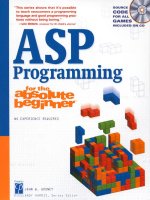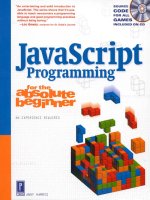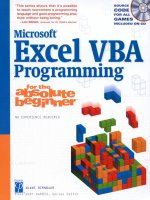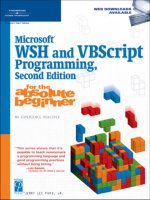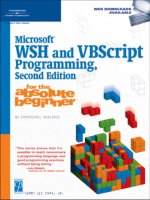C Programming for the Absolute Beginner phần 7 pptx
Bạn đang xem bản rút gọn của tài liệu. Xem và tải ngay bản đầy đủ của tài liệu tại đây (14.98 MB, 35 trang )
main()
{
char myString[21] = {0};
int iSelection = 0;
int iRand;
srand(time(NULL));
iRand = (rand() % 4) + 1; // random #, 1-4
while ( iSelection != 4 ) {
printf("\n\n1\tEncrypt Clear Text\n");
printf("2\tDecrypt Cipher Text\n");
printf("3\tGenerate New Key\n");
printf("4\tQuit\n");
printf("\nSelect a Cryptography Option: ");
scanf("%d", &iSelection);
switch (iSelection) {
case 1:
printf("\nEnter one word as clear text to encrypt: ");
scanf("%s", myString);
encrypt(myString, iRand);
break;
case 2:
printf("\nEnter cipher text to decrypt: ");
scanf("%s", myString);
decrypt(myString, iRand);
break;
case 3:
iRand = (rand() % 4) + 1; // random #, 1-4
printf("\nNew Key Generated\n");
C Programming for the Absolute Beginner, Second Edition
174
break;
} //end switch
} //end loop
} //end main
void encrypt(char sMessage[], int random)
{
int x = 0;
//encrypt the message by shifting each characters ASCII value
while ( sMessage[x] ) {
sMessage[x] += random;
x++;
} //end loop
x = 0;
printf("\nEncrypted Message is: ");
//print the encrypted message
while ( sMessage[x] ) {
printf("%c", sMessage[x]);
x++;
} //end loop
} //end encrypt function
void decrypt(char sMessage[], int random)
{
int x = 0;
Chapter 7 • Pointers
175
x = 0;
//decrypt the message by shifting each characters ASCII value
while ( sMessage[x] ) {
sMessage[x] = sMessage[x] - random;
x++;
} //end loop
x = 0;
printf("\nDecrypted Message is: ");
//print the decrypted message
while ( sMessage[x] ) {
printf("%c", sMessage[x]);
x++;
} //end loop
} //end decrypt function
S
UMMARY
• Pointers are variables that contain a memory address that points to another variable.
• Place the indirection operator (
*) in front of the variable name to declare a pointer.
• The unary operator (
&) is often referred to as the “address of” operator.
• Pointer variables should always be initialized with another variable’s memory address,
with
0, or with the keyword NULL.
• You can print the memory address of pointers using the
%p conversion specifier.
• By default, arguments are passed by value in C, which involves making a copy of the
incoming argument for the function to use.
• Pointers can be used to pass arguments by reference.
• Passing an array name to a pointer assigns the first memory location of the array to the
pointer variable. Similarly, initializing a pointer to an array name stores the first address
of the array in the pointer.
• You can use the
const qualifier in conjunction with pointers to achieve a read-only
argument while still achieving the pass by reference capability.
C Programming for the Absolute Beginner, Second Edition
176
Challenges
1. Build a program that performs the following operations:
•
Declares three pointer variables called
iPtr
of type
int
,
cPtr
of type
char
, and
fFloat
of type
float
.
•
Declares three new variables called
iNumber
of
int
type,
fNumber
of
float
type, and
cCharacter
of
char
type.
•
Assigns the address of each non-pointer variable to the
matching pointer variable.
•
Prints the value of each non-pointer variable.
•
Prints the value of each pointer variable.
•
Prints the address of each non-pointer variable.
•
Prints the address of each pointer variable.
2. Create a program that allows a user to select one of the following
four menu options:
•
Enter New Integer Value
•
Print Pointer Address
•
Print Integer Address
•
Print Integer Value
For this program you will need to create two variables: one integer
data type and one pointer. Using indirection, assign any new
integer value entered by the user through an appropriate pointer.
3. Create a dice rolling game. The game should allow a user to toss
up to six dice at a time. Each toss of a die will be stored in a six-
element integer array. The array will be created in the
main()
function, but passed to a new function called
TossDie()
. The
TossDie()
function will take care of generating random numbers
from one to six and assigning them to the appropriate array
element number.
4. Modify the Cryptogram program to use a different type of key
system or algorithm. Consider using a user-defined key or a
different character set.
Chapter 7 • Pointers
177
This page intentionally left blank
8
C HAP TE R
STRINGS
trings use many concepts you have already learned about in this book,
such as functions, arrays, and pointers. This chapter shows you how to
build and use strings in your C programs while also outlining the intimate
relationships strings have with pointers and arrays. You will also learn many new
common library functions for manipulating, converting, and searching strings, as
well as the following:
• Reading and printing strings
• String arrays
• Converting strings to numbers
• Manipulating strings
• Analyzing strings
I
NTRODUCTION TO
S
TRINGS
Strings are groupings of letters, numbers, and many other characters. C program-
mers can create and initialize a string using a character array and a terminating
NULL character, as shown next.
char myString[5] = {'M', 'i', 'k', 'e', '\0'};
Figure 8.1 depicts this declared array of characters.
S
When creating character arrays, it is important to allocate enough room for the
NULL character because many C library functions look for the NULL character
when processing character arrays. If the
NULL character is not found, some C
library functions may not produce the desired result.
FIGURE 8.1
Depicting an array
of characters.
The variable myString can also be created and initialized with a string literal. String literals are
groupings of characters enclosed in quotation marks, as shown next.
char myString[] = "Mike";
Assigning a string literal to a character array, as the preceding code shows, creates the nec-
essary number of memory elements—in this case five including the
NULL character.
String literals
are a series of characters surrounded by double quotes.
You know that strings are arrays of characters in a logical sense, but it’s just as important to
know that strings are implemented as a pointer to a segment of memory. More specifically,
string names are really just pointers that point to the first character’s memory address in
a string.
To demonstrate this thought, consider the following program statement.
char *myString = "Mike";
This statement declares a pointer variable and assigns the string literal "Mike" to the first and
subsequent memory locations that the pointer variable
myString points to. In other words,
the pointer variable
myString points to the first character in the string "Mike".
CAUTION
TIP
C Programming for the Absolute Beginner, Second Edition
180
To further demonstrate this concept, study the following program and its output in
Figure 8.2, which reveals how strings can be referenced through pointers and traversed sim-
ilar to arrays.
#include <stdio.h>
main()
{
char *myString = "Mike";
int x;
printf("\nThe pointer variable's value is: %p\n", *myString);
printf("\nThe pointer variable points to: %s\n", myString);
printf("\nThe memory locations for each character are: \n\n");
//access & print each memory address in hexadecimal format
for ( x = 0; x < 5; x++ )
printf("%p\n", myString[x]);
} //end main
FIGURE 8.2
Creating,
manipulating, and
printing strings
with pointers and
arrays of
characters.
Chapter 8 • Strings
181
Are Strings Data Types?
The concept of a string is sometimes taken for granted in high-level languages such as Visual
Basic. This is because many high-level languages implement strings as a data type, just like an
integer or double. In fact, you may be thinking—or at least hoping—that C contains a string data
type as shown next.
str myString = "Mike"; //not possible, no such data type
string myString = "Mike"; //not possible, no such data type
C does not identify strings as a data type; rather C strings are simply character arrays.
Figure 8.3 further depicts the notion of strings as pointers.
FIGURE 8.3
Using pointers,
memory
addresses, and
characters to
demonstrate how
strings are
assembled.
After studying the preceding program and Figure 8.3, you can see how the pointer variable
myString contains the value of a memory address (printed in hexadecimal format) that points
to the first character in the string
"Mike", followed by subsequent characters and finally the
NULL zero to indicate the end of the string.
C Programming for the Absolute Beginner, Second Edition
182
In the next few sections, you will continue your investigation into strings and their use by
learning how to handle string I/O and how to convert, manipulate, and search strings using
a few old and new C libraries and their associated functions.
R
EADING AND
P
RINTING
S
TRINGS
Chapter 6, “Arrays,” provided you with an overview of how to read and print array contents.
To read and print a character array use the
%s conversion specifier as demonstrated in the
next program.
#include <stdio.h>
main()
{
char color[12] = {'\0'};
printf("Enter your favorite color: ");
scanf("%s", color);
printf("\nYou entered: %s", color);
} //end main
The preceding program demonstrates reading a string into a character array with initialized
and allocated memory (
char color[12] = {'\0'};), but what about reading strings from stan-
dard input for which you do not know the string length? This is often overlooked in many C
texts. It might be natural to assume you can use the standard library’s
scanf() function, as
demonstrated next, to capture and assign string data from standard input to a variable.
#include <stdio.h>
main()
{
char *color;
printf("\nEnter your favorite color: ");
Chapter 8 • Strings
183
scanf("%s", color); //this will NOT work!
printf("\nYou entered: %s", color);
} //end main
Unfortunately, this program will not work; it will compile, but it will not work. Figure 8.4
demonstrates the inevitable outcome of running the preceding program.
FIGURE 8.4
Reading a string
from standard
input without
allocating
memory.
This problem occurs because not only must you declare a string as a pointer to a character,
but you must also allocate memory for it. Remember that when first created, a string is noth-
ing more than a pointer that points to nothing valid. Moreover, when the
scanf() function
attempts to assign data to the pointer’s location, the program crashes because memory has
not been properly allocated.
For now, you should simply use initialized character arrays with sufficient memory allocated
to read strings from standard input. In Chapter 10, “Dynamic Memory Allocation,” I will
discuss the secret to assigning data from standard input to strings (pointer variables).
S
TRING
A
RRAYS
Now you know strings are pointers and that strings, in an abstract sense, are arrays of
characters. So, if you need an array of strings, do you need a two-dimensional array or a
single-dimension array? The correct answer is both. You can create an array of strings with
a one-dimensional pointer array and assign string literals to it or you can create a two-
dimensional pointer array, allowing C to reserve enough memory for each character array.
To demonstrate how an array of strings can be created using a single-dimension pointer array
of type
char, study the following program and its output shown in Figure 8.5.
C Programming for the Absolute Beginner, Second Edition
184
#include <stdio.h>
main()
{
char *strNames[5] = {0};
char answer[80] = {0};
int x;
strNames[0] = "Michael";
strNames[1] = "Sheila";
strNames[2] = "Spencer";
strNames[3] = "Hunter";
strNames[4] = "Kenya";
printf("\nNames in pointer array of type char:\n\n");
for ( x = 0; x < 5; x++ )
printf("%s\n", strNames[x]);
} //end main
FIGURE 8.5
Printing strings
with a character
pointer array.
In the preceding program, it is very important to note that this array of strings is really an
array of character pointers. C is able to treat each element in the array as a string because
I used string literals, which C places in protected memory.
Chapter 8 • Strings
185
Another way to simulate an array of strings is to use a two-dimensional pointer array of type
char as seen in the next program.
#include <stdio.h>
main()
{
char *colors[3][10] = {'\0'};
printf("\nEnter 3 colors seperated by spaces: ");
scanf("%s %s %s", colors[0], colors[1], colors[2]);
printf("\nYour entered: ");
printf("%s %s %s\n", colors[0], colors[1], colors[2]);
}
In the preceding program I declared a 3x10 (three by ten) two-dimensional character array
that reserves enough memory for 30 characters. Notice I only need to tell C to reference the
first dimension of each element in the character array when referencing a single string.
Providing I’ve allocated enough elements in the second dimension, I can easily use
scanf()
to grab text entered by the user. In Chapter 10, I will show you how to grab portions of
contiguous memory without first allocating it in an array.
C
ONVERTING
S
TRINGS TO
N
UMBERS
When dealing with ASCII characters, how do you differentiate between numbers and letters?
The answer is two-fold. First, programmers assign like characters to various data types, such
as characters (
char) and integers (int), to differentiate between numbers and letters. This is a
straightforward and well-understood approach for differentiating between data types. But
there are less defined occasions when programmers will need to convert data from one type
to another. For example, there will be times when you will want to convert a string to a
number.
Fortunately, the C standard library
stdlib.h provides a few functions that serve the purpose
of converting strings to numbers. A couple of the most common string conversion functions
are shown next.
C Programming for the Absolute Beginner, Second Edition
186
• atof—Converts a string to a floating-point number
•
atoi—Converts a string to an integer
Both of these functions are demonstrated in the next program and the output is shown in
Figure 8.6.
#include <stdio.h>
#include <stdlib.h>
main()
{
char *str1 = "123.79";
char *str2 = "55";
float x;
int y;
printf("\nString 1 is \"%s\"\n", str1);
printf("String 2 is \"%s\"\n", str2);
x = atof(str1);
y = atoi(str2);
printf("\nString 1 converted to a float is %.2f\n", x);
printf("String 2 converted to an integer is %d\n", y);
} //end main
FIGURE 8.6
Converting string
literals to numeric
types float and
int.
Chapter 8 • Strings
187
When printed to standard output, strings are not surrounded by quotes auto-
matically, as depicted in Figure 8.6. This illusion can be accomplished by using
special quote characters in a
printf() function. You can display quotes in stan-
dard output using a conversion specifier, more specifically the
\" conversion
specifier, as the next print statement demonstrates.
printf("\nString 1 is \"%s\"\n", str1);
You may be wondering why string conversion is so important. Well, for example, attempting
numeric arithmetic on strings can produce unexpected results as demonstrated in the next
program and in Figure 8.7.
#include <stdio.h>
main()
{
char *str1 = "37";
char *str2 = "20";
//produces invalid results
printf("\nString 1 + String 2 is %d\n", *str1 + *str2);
} //end main
FIGURE 8.7
Invalid arithmetic
results generated
by not converting
strings to
numbers.
In the preceding code, I tried to convert the result using the %d conversion specifier. (%d is the
decimal integer conversion specifier.) This is not enough, however, to convert strings or char-
acter arrays to numbers, as demonstrated in Figure 8.7.
TIP
C Programming for the Absolute Beginner, Second Edition
188
To correct this problem, you can use string conversion functions, as demonstrated in the next
program and its output in Figure 8.8.
#include <stdio.h>
main()
{
char *str1 = "37";
char *str2 = "20";
int iResult;
iResult = atoi(str1) + atoi(str2);
printf("\nString 1 + String 2 is %d\n", iResult);
} //end main
FIGURE 8.8
Using the atoi
function to
convert strings to
numbers.
M
ANIPULATING
S
TRINGS
A common practice among programmers is manipulating string data, such as copying one
string into another and concatenating (gluing) strings to each other. Also common is the need
to convert strings to either all lowercase or all uppercase, which can be important when
comparing one string to another. I will show you how to perform these string manipulations
in the following sections.
Chapter 8 • Strings
189
strlen()
The string length (strlen()) function is part of the string-handling library <string.h> and is
quite simple to understand and use.
strlen() takes a reference to a string and returns the
numeric string length up to the
NULL or terminating character, but not including the NULL
character.
The next program and Figure 8.9 demonstrate the
strlen() function.
#include <stdio.h>
#include <string.h>
main()
{
char *str1 = "Michael";
char str2[] = "Vine";
printf("\nThe length of string 1 is %d\n", strlen(str1));
printf("The length of string 2 is %d\n", strlen(str2));
} // end main
FIGURE 8.9
Using the
strlen() function
to determine the
length of strings.
tolower() and toupper()
An important reason for converting strings to either all uppercase or all lowercase is for string
comparisons.
C Programming for the Absolute Beginner, Second Edition
190
The character-handling library <ctype.h> provides many character manipulation functions
such as
tolower() and toupper(). These functions provide an easy way to convert a single
character to either uppercase or lowercase (notice I said single character). To convert an entire
character array to either all uppercase or all lowercase, you will need to work a little harder.
One solution is to build your own user-defined functions for converting character arrays
to uppercase or lowercase by looping through each character in the string and using the
strlen() function to determine when to stop looping and converting each character to either
lower- or uppercase with
tolower() and toupper(). This solution is demonstrated in the next
program, which uses two user-defined functions and, of course, the character handling func-
tions
tolower() and toupper() to convert my first name to all lowercase and my last name to
all uppercase. The output is shown in Figure 8.10.
#include <stdio.h>
#include <ctype.h>
//function prototypes
void convertL(char *);
void convertU(char *);
main()
{
char name1[] = "Michael";
char name2[] = "Vine";
convertL(name1);
convertU(name2);
} //end main
void convertL(char *str)
{
int x;
for ( x = 0; x <= strlen(str); x++ )
Chapter 8 • Strings
191
str[x] = tolower(str[x]);
printf("\nFirst name converted to lower case is %s\n", str);
} // end convertL
void convertU(char *str)
{
int x;
for ( x = 0; x <= strlen(str); x++ )
str[x] = toupper(str[x]);
printf("Last name converted to upper case is %s\n", str);
} // end convertU
FIGURE 8.10
Manipulating
character arrays
with functions
tolower() and
toupper().
strcpy()
The strcpy() function copies the contents of one string into another string. As you might
imagine, it takes two arguments and is pretty straightforward to use, as the next program
and Figure 8.11 demonstrate.
#include <stdio.h>
#include <string.h>
C Programming for the Absolute Beginner, Second Edition
192
main()
{
char str1[11];
char *str2 = "C Language";
printf("\nString 1 now contains %s\n", strcpy(str1, str2));
} // end main
FIGURE 8.11
The output of
copying one string
to another using
the strcpy()
function.
The strcpy() function takes two strings as arguments. The first argument is the string to be
copied into and the second argument is the string that will be copied from. After copying
string 2 (second argument) into string 1 (first argument), the
strcpy() function returns the
value of string 1.
Note that I declared string 1 (
str1) as a character array rather than as a pointer to a char type.
Moreover, I gave the character array 11 elements to handle the number characters plus a
NULL character. You cannot assign data to an empty string without first allocating memory to
it. I’ll discuss this more in Chapter 10.
strcat()
Another interesting and sometimes useful string library function is the strcat() function,
which concatenates or glues one string to another.
To
concatenate
is to glue one or more pieces of data together or to connect one
or more links together.
TIP
Chapter 8 • Strings
193
Like the strcpy() function, the strcat() function takes two string arguments, as the next
program demonstrates.
#include <stdio.h>
#include <string.h>
main()
{
char str1[40] = "Computer Science ";
char str2[] = "is applied mathematics";
printf("\n%s\n", strcat(str1, str2));
} // end main
As Figure 8.12 demonstrates, the second string argument (str2) is concatenated to the first
string argument (
str1). After concatenating the two strings, the strcat() function returns
the value in
str1. Note that I had to include an extra space at the end of str1 “Computer
Science”, because the
strcat() function does not add a space between the two merged strings.
FIGURE 8.12
Using the
strcat()
function to glue
strings together.
A
NALYZING
S
TRINGS
In the next couple of sections, I will discuss a few more functions of the string-handling library
that allow you to perform various analyses of strings. More specifically, you will learn how to
compare two strings for equality and search strings for the occurrence of characters.
C Programming for the Absolute Beginner, Second Edition
194
strcmp()
The strcmp() function is a very interesting and useful function that is primarily used to com-
pare two strings for equality. Comparing strings is actually a common process for computer
and non-computer uses. To demonstrate, consider an old library card-catalog system that used
human labor to manually sort book references by various keys (author name, ISBN, title, and
so on). Most modern libraries now rely on computer systems and software to automate the
process of sorting data for the card catalog system. Keep in mind, the computer does not know
that letter A is greater than letter B, or better yet, that the exclamation mark (!) is greater than
the letter A. To differentiate between characters, computer systems rely on character codes
such as the ASCII character-coding system.
Using character-coding systems, programmers can build sorting software that compares
strings (characters). Moreover, C programmers can use built-in string-handling functions,
such as
strcmp(), to accomplish the same. To prove this, study the following program and its
output shown in Figure 8.13.
#include <stdio.h>
#include <string.h>
main()
{
char *str1 = "A";
char *str2 = "A";
char *str3 = "!";
printf("\nstr1 = %s\n", str1);
printf("\nstr2 = %s\n", str2);
printf("\nstr3 = %s\n", str3);
printf("\nstrcmp(str1, str2) = %d\n", strcmp(str1, str2));
printf("\nstrcmp(str1, str3) = %d\n", strcmp(str1, str3));
printf("\nstrcmp(str3, str1) = %d\n", strcmp(str3, str1));
if ( strcmp(str1, str2) == 0 )
printf("\nLetter A is equal to letter A\n");
Chapter 8 • Strings
195
if ( strcmp(str1, str3) > 0 )
printf("Letter A is greater than character !\n");
if ( strcmp(str3, str1) < 0 )
printf("Character ! is less than letter A\n");
} // end main
FIGURE 8.13
Comparing strings
using the
strcmp()
function.
The strcmp() function takes two strings as arguments and compares them using correspond-
ing character codes. After comparing the two strings, the
strcmp() function returns a single
numeric value that indicates whether the first string is equal to, less than, or greater than
the second string. Table 8.1 describes the
strcmp() function’s return values in further detail.
T
ABLE
8.1 R
ETURN
V
ALUES AND
D
ESCRIPTIONS FOR THE
STRCMP
() F
UNCTION
Sample Function Return Value Description
strcmp(string1, string2)
0 string1 is equal to string2
strcmp(string1, string2)
<0 string1 is less than string2
strcmp(string1, string2)
>0 string1 is greater than string2
strstr()
The strstr() function is a very useful function for analyzing two strings. More specifically,
the
strstr() function takes two strings as arguments and searches the first string for an
occurrence of the second string. This type of search capability is demonstrated in the next
program and its output is shown in Figure 8.14.
C Programming for the Absolute Beginner, Second Edition
196
#include <stdio.h>
#include <string.h>
main()
{
char *str1 = "Analyzing strings with the strstr() function";
char *str2 = "ing";
char *str3 = "xyz";
printf("\nstr1 = %s\n", str1);
printf("\nstr2 = %s\n", str2);
printf("\nstr3 = %s\n", str3);
if ( strstr(str1, str2) != NULL )
printf("\nstr2 was found in str1\n");
else
printf("\nstr2 was not found in str1\n");
if ( strstr(str1, str3) != NULL )
printf("\nstr3 was found in str1\n");
else
printf("\nstr3 was not found in str1\n");
} // end main
FIGURE 8.14
Using the
strstr()
function to search
one string for
another.
Chapter 8 • Strings
197
As you can see from the preceding program, the strstr() function takes two strings as argu-
ments. The
strstr() function looks for the first occurrence of the second argument in the
first argument. If the string in the second argument is found in the string in the first argu-
ment, the
strstr() function returns a pointer to the string in the first argument. Otherwise
NULL is returned.
C
HAPTER
P
ROGRAM
—W
ORD
F
IND
The Word Find program is a straightforward program that uses strings and many other
chapter-based concepts to create a fun and easy-to-play game. Specifically, it uses concepts
and techniques such as arrays and string-based functions that manipulate and analyze strings
to build a game. The object of the Word Find game is to challenge a user to find a single word
among seemingly meaningless text (see Figure 8.15). All of the code needed to build the Word
Find game is shown next.
FIGURE 8.15
Using chapter-
based concepts to
build the Word
Find program.
#include <stdio.h>
#include <string.h>
//function prototypes
void checkAnswer(char *, char []);
main()
{
char *strGame[5] = {"ADELANGUAGEFERVZOPIBMOU",
"ZBPOINTERSKLMLOOPMNOCOT",
"PODSTRINGGDIWHIEEICERLS",
C Programming for the Absolute Beginner, Second Edition
198

